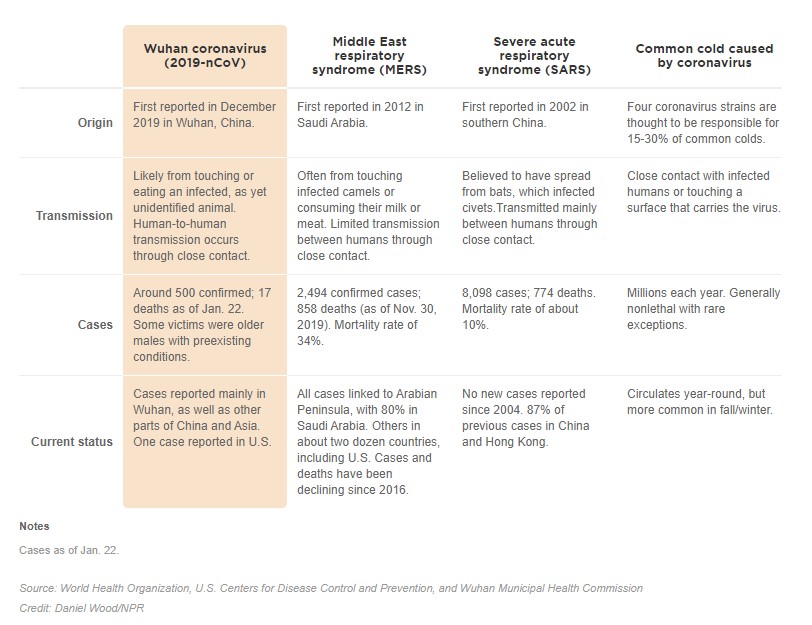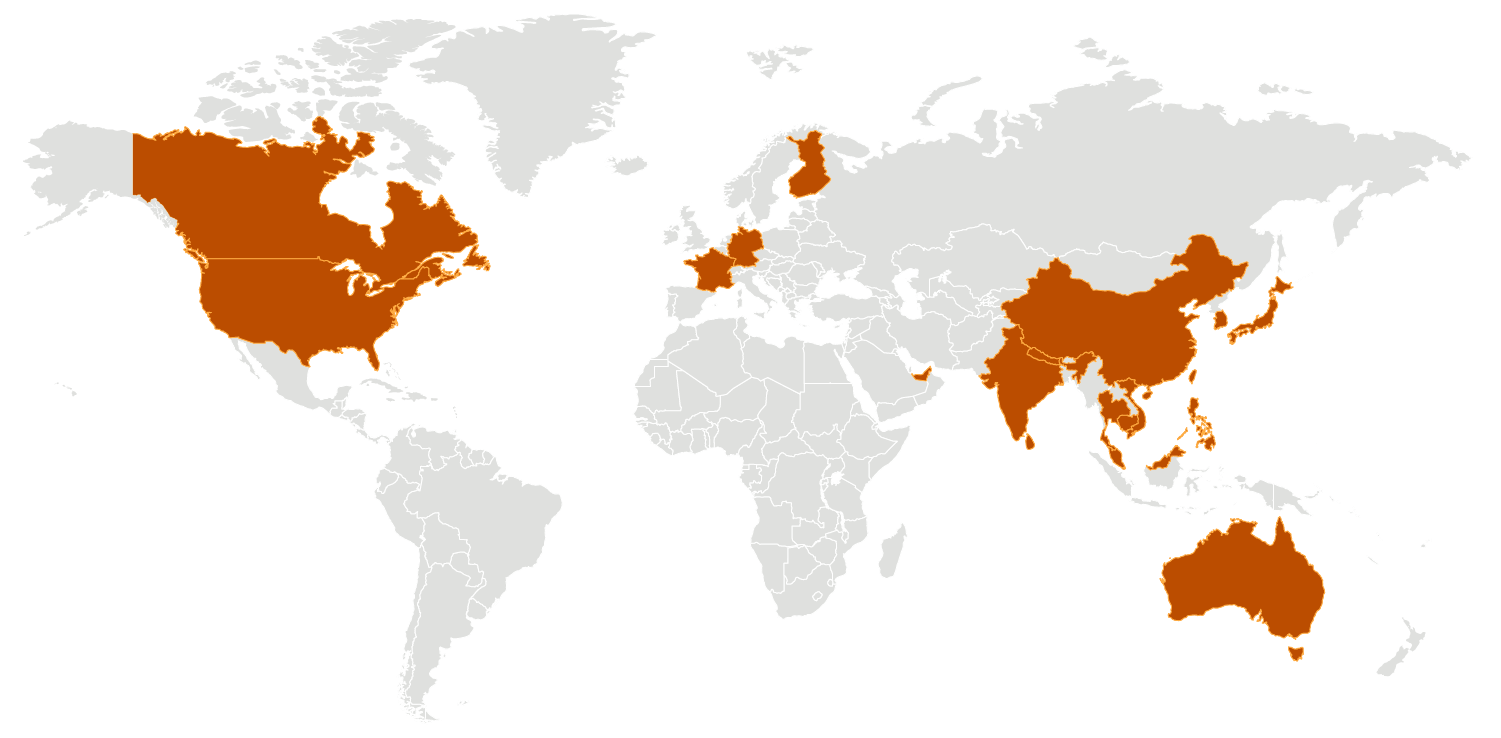
On December 31, 2019, Chinese officials announced that 27 people in Wuhan, the capital of Central China’s Hubei province, had been infected with a new strain of the coronavirus. Since then, the number of cases of the contagious affliction labeled 2019-nCoV, COVID-19, or Wuhan virus, have rapidly increased, with new cases being reported daily. On Thursday, January 30, 2020, The World Health Organization (WHO) declared the outbreak a global emergency, highlighting the urgency for a rapid coordinated international response to curb this global health risk.
As of January 31, 2020, 7,711 instances of the infection, including 200 deaths, had been reported in China. Additionally, about 100 people in 19 countries, including the United States, Germany, France, South Korea, and Singapore, have also tested positive for the virus. Here is everything you need to know about the Wuhan virus, which has gripped the world's attention since the beginning of 2020.
What is a coronavirus?

Coronaviruses are a common cause of colds and other upper respiratory infections in humans and certain other mammals and birds. The microbes, which get their name from the crown-like ("corona" in Latin) spikes on their surface, are zoonotic, which means they can easily spread from one animal to another. Every now and again, an animal coronavirus mutates to infect humans, leading to contagious respiratory infections that have never been encountered before. This makes it harder for physicians to diagnose and cure, and results in outbreaks similar to the one the world is currently undergoing.
How often do coronaviruses evolve to infect humans?

While there are hundreds of coronaviruses, only seven have thus far evolved to infect humans. Of these, only two have resulted in outbreaks. Severe Acute Respiratory Syndrome (SARS), which originated in the Guangdong province of southern China in November 2002, infected a total of 8,098 people worldwide, resulting in 774 deaths, before it was contained in July 2003. The microbes were believed to have been transmitted to humans by the cave-dwelling horseshoe bats in China's Yunnan province.
Though the first case of the Middle East Respiratory Syndrome (MERS) occurred in Saudi Arabia in April 2012, the infection remained relatively contained until 2014, when the numbers suddenly began to rise. By the time it was contained in late 2015, 1,329 cases, including 525 deaths, had been attributed to the infection. A 2014 study published in The New England Journal of Medicine indicated that the microbes responsible for MERS had originated from camels.
From where did the Wuhan virus originate?
Since it was first observed primarily in stallholders, the Wuhan virus is believed to have originated from the Wuhan seafood market, which also trades in illegal wildlife like bats, marmots, birds, and snakes. Although an initial analysis of the microbes suggested the new strain was similar to the coronavirus encountered in snakes, scientists now believe that, similar to SARS, the Wuhan virus is a mutation from bats.
What is being done to stop the virus from spreading further?

Since January 22, 2020, Chinese authorities have imposed a travel ban on the 11 million residents of Wuhan and suspended all buses, ferries, trains, and flights out of the city. Public transportation has also been halted in the nearby cities of Huanggang, Ezhou, Zhejiang, and Chibi, which together are home to more than nine million residents, and Xiantao and Qianjiang, two other cities that include large rural populations.
Meanwhile, Wuhan officials are closely tracking the health of the family members of all infected patients, as well as the residents who visited the now shuttered market around the time the virus was first detected. The Chinese government has installed infrared thermometers at exit points across the country. Anyone registering even a slight fever is instantly taken to a medical center for diagnosis and treatment.
Similar measures are being taken worldwide to stop the spread of the virus. On Tuesday, January 28, 2020, Hong Kong officials announced restricting or closing some of its border crossings with mainland China. They also shut down all schools until March 2020.
On Friday, January 31, 2020, three major US airlines — United, American, and Delta — announced they were halting all flights to mainland China until further notice. Additionally, all flights from China to the U.S. will be funneled to one of seven airports, where enhanced public health screenings will be required for Americans returning from China. These include, Los Angeles International, San Francisco International, Honolulu International, Seattle-Tacoma International, New York's John F. Kennedy International, Chicago O'Hare International, and Atlanta’s Hartsfield-Jackson International. Meanwhile, US corporations like Apple Inc. and Amazon have banned US employees from traveling to the country and are asking their employees in China to work from home.
What are the symptoms of the Wuhan virus?

The symptoms of the Wuhan virus are similar to those experienced when afflicted with the flu. They include fever, cough, fatigue, muscle pain, and shortness of breath. Some victims have also experienced severe headaches and diarrhea.
There is no specific treatment currently available for those infected with the new coronavirus. However, the US Centers of Disease Control and Prevention (CDC) maintains that, if diagnosed in a timely manner, most people will recover on their own by simply resting and taking commonly-available cold medication to relieve symptoms. Additionally, the disease's most severe cases have thus far been restricted to the elderly or those with a preexisting respiratory illness.
What precautions can I take?
Though scientists are not entirely sure how this virus is spreading, coronaviruses typically pass through droplets containing large particles that can only be suspended in the air for three to six feet before dissipating. Hence, they recommend taking simple precautions, like washing hands frequently and thoroughly, avoiding touching your eyes, nose, or mouth with your hands, and staying away from people displaying flu-like symptoms. Those experiencing any of the symptoms associated with the virus are advised to cover their coughs and sneezes with their inner elbows. Most importantly, however, they should stay away from school, work, or any public area where they have the risk of infecting others.
Bottom line
Experts say that unless you have been in close contact with someone who has the coronavirus — which right now, typically means an infected traveler from Wuhan, China — you can rest easy. While things may change in the future, the CDC currently maintains that most US residents have a higher chance of contracting the common flu than the Wuhan virus!
Resources: Cnet.com, whoint.com, CDC.gov, CNN.com,LAtimes.com
